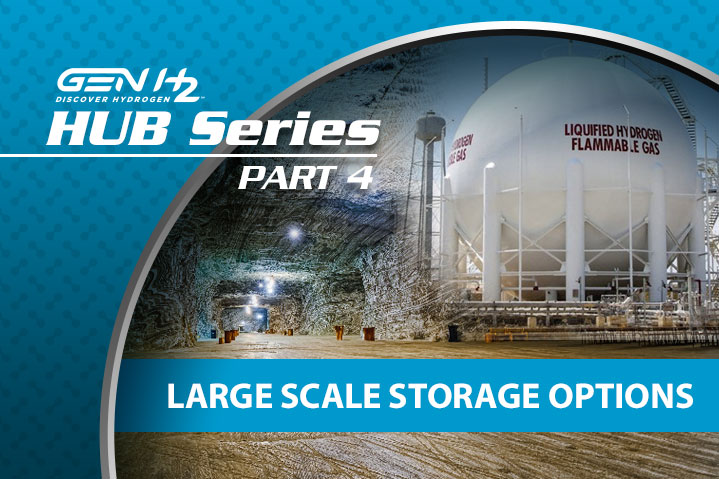Hub Series: Part 4
By: GenH2 Staff
Read Time: 4 minutes
Large-Scale Storage Options to supply Hydrogen Hub
Throughout our Hub Series, we have discussed what Hydrogen Hubs are and why they are essential. These hubs will integrate hydrogen-based energy services in a connective infrastructure located in close proximity that will connect hydrogen producers and consumers.
In order for Hydrogen Hubs to demonstrate the successful production and use of clean hydrogen, physical infrastructure that provides a large-scale solution to hydrogen storage will also be required. These large-scale storage options include salt caverns and large storage tanks or can be referred to as GigaSphere tanks. These options are able to store hydrogen in very large quantities where it is produced and subsequently make it available when and where the electric grid requires it.
The storage of hydrogen in salt caverns are created by injecting fresh water, or water with low salt content, into a well that is located within the earth’s salt geological layer, from which salt-saturated brine is extracted. These caverns can measure between 50 and 100 meters in diameter, and up to several hundred meters tall, and must be placed where the salt formation has the necessary thickness. Salt caverns do not need to be artificially lined, as the salt itself acts as a sealant. This type of storage is suitable for storing hydrogen at extremely high pressures in areas where the salt layer is deep enough.
Hydrogen is already being stored underground in salt caverns in a few places in the United Kingdom and the United States, but these sites have not been tested to see if hydrogen can be injected and extracted at a rapid rate. For example, in Europe, salt caverns are widely used today, particularly for storing methane (‘natural gas’). They take advantage of the presence of salt layers or domes in the subsoil several hundred meters thick, that extend over large areas. In France, there are about thirty gas storage cavities spread over three sites occupying around 20,000 km2, with thicknesses that can reach one kilometer.
Here in the U.S., there are plans for hydrogen salt cavern storage possibly a in small town in Utah which could potentially become the largest Hydrogen Hub in the world, and in other states such as Mississippi. The Utah town of Delta can be found in the rural desert where developers are planning to create caverns in ancient salt dome formations underground where they hope to store hydrogen fuel at an unprecedented scale. Delta is home to the Intermountain Power Project (IPP), a nonprofit energy co-op managed by the Intermountain Power Authority (IPA). IPP is situated over the only known salt dome in the western US and an extremely large one at that.
The IPP’s coal-fired asset plant is closing and a new venture, The Advanced Clean Energy Storage Project, has just received a conditional commitment for $504.4 million from the Department of Energy’s (DOE’s) federal loan guarantee program. By 2025, the plant is set to deliver renewable energy for storage to the Advanced Clean Energy Storage (ACES)-Delta where it will be converted to green hydrogen. The green hydrogen will be created by splitting H2O atoms via electrolysis. This process itself will be powered by solar or wind energy, and the hydrogen will then be stored in the salt caverns.
But how can hydrogen be stored at large-scale if there is not a feasible salt cavern in proximity to a Hydrogen Hub? In this case, hydrogen must be liquefied and stored in large, highly insulated storage tanks. Such large-scale tanks are vacuum-jacketed spheres with a bulk-fill insulation material in the annular space.
Vacuum-jacketed spherical storage tanks have been used to store liquid hydrogen (LH2) for decades. The largest liquid hydrogen storage tank in the world is located at NASA Kennedy Space Center. This tank, completed in 2022, has a liquid capacity of 4,800 cubic meters and incorporates the use of two new technologies for highest efficiency and advanced performance capabilities. These technologies, co-developed by GenH2 Chief Architect, James Fesmire, include evacuated glass bubbles insulation system and internal heat exchanger for refrigeration capability. Larger tanks of similar design of up to 20,000 cubic meters are on the drawing board and these advanced storage tanks, or GigaSpheres, are considered to be the next generation of large liquid hydrogen storage solutions. Wherever the GigaSphere is placed, it can be the primary dispensing source, or it can feed a network of satellite dispensing units, as well as provide key infrastructure around hubs.
Strategically placed GigaSpheres, which will enable feeder distribution to smaller locations for dispensing and developing a network, is in fact more efficient than deploying isolated units. GigaSpheres are expected to become the anchors for each hydrogen hub over the next decade. With GigaSpheres in place, hubs will have the capability to advance the essential role of hydrogen to support all facets of our energy needs by 2030 and beyond. Beyond GigaSpheres, for global energy carriers, are even bigger storage tanks up to 100,000 cubic meters for overseas transport of the liquid hydrogen. GenH2 is also contributing to the development of these tanks. Continue following us in this series as we get into the Key Components of Hydrogen Hubs and the Innovative solutions driving us closer and closer to our clean energy goal.



